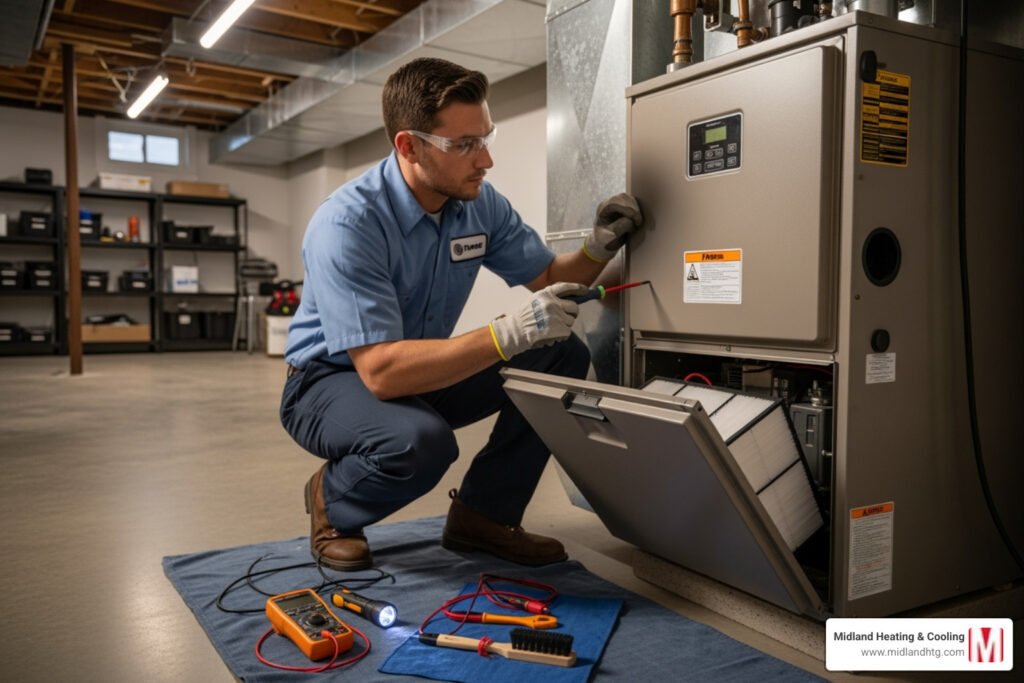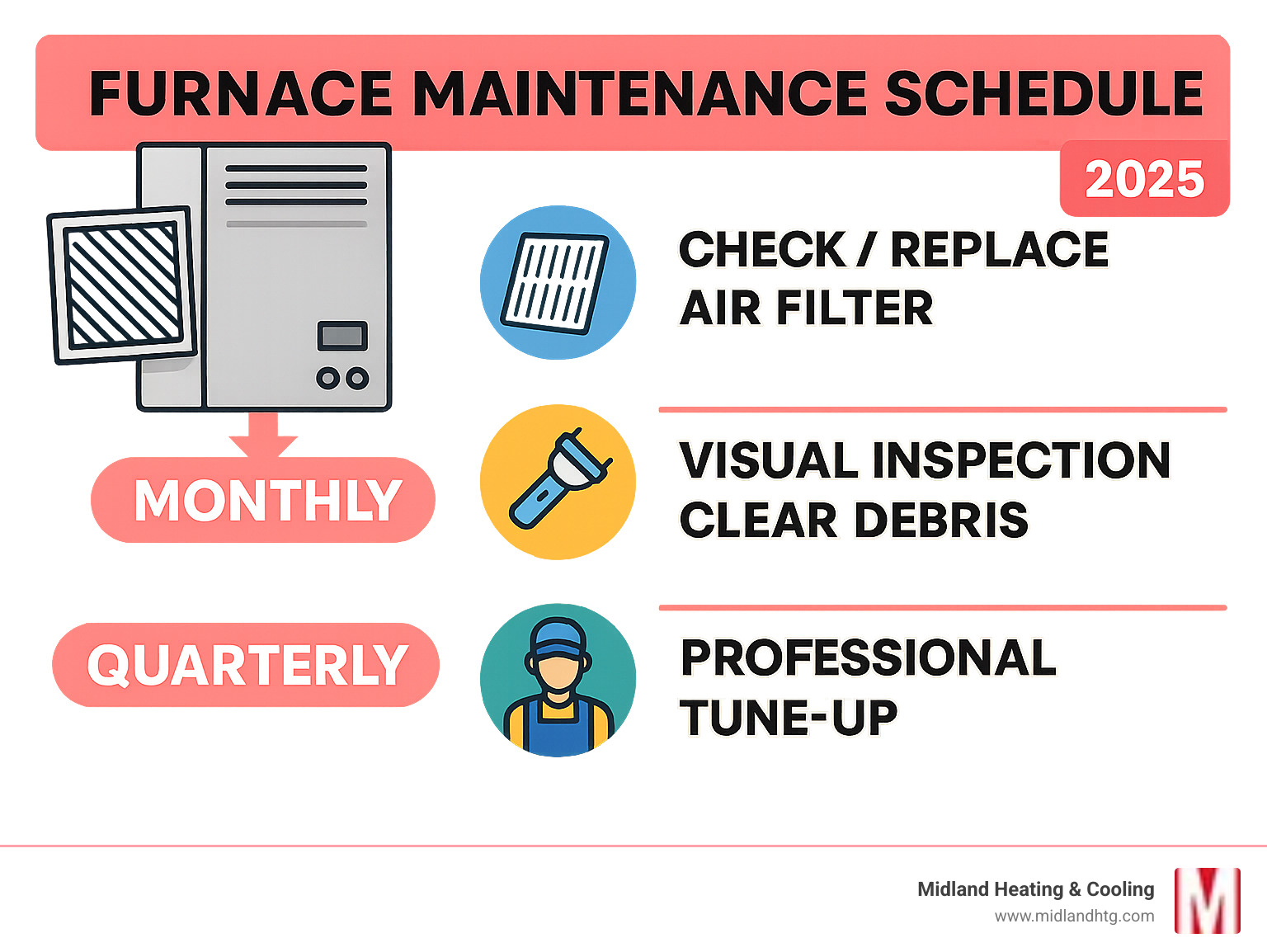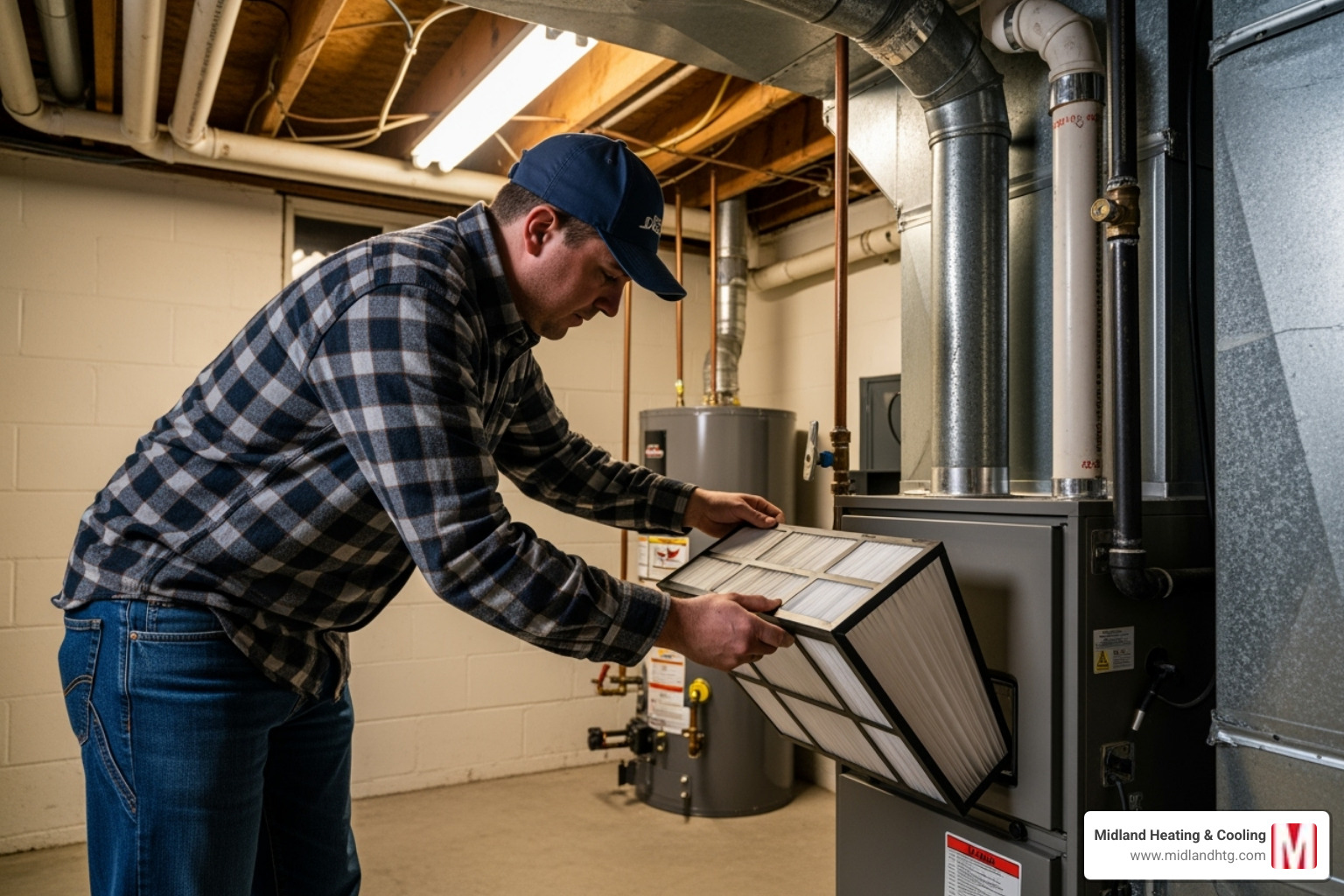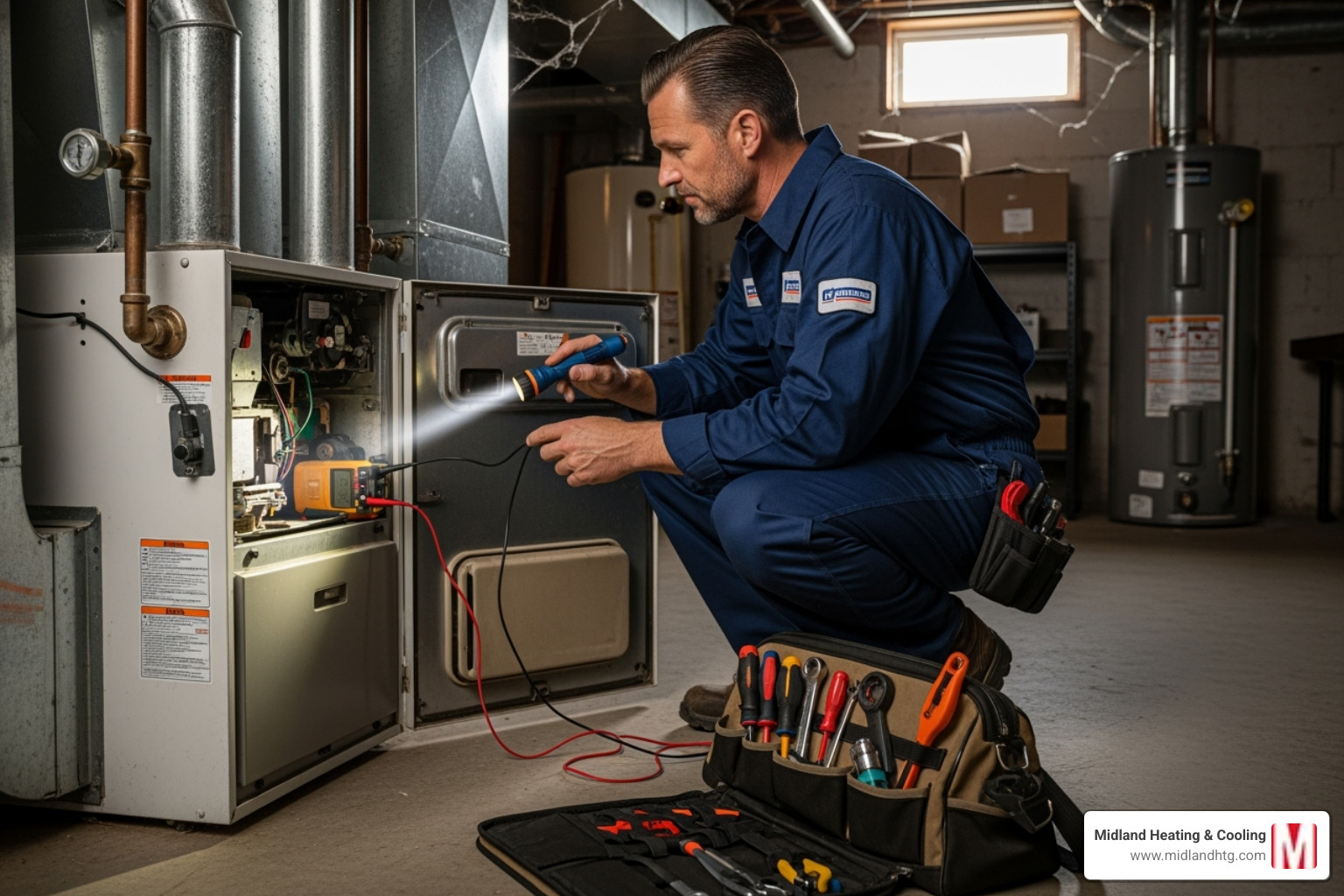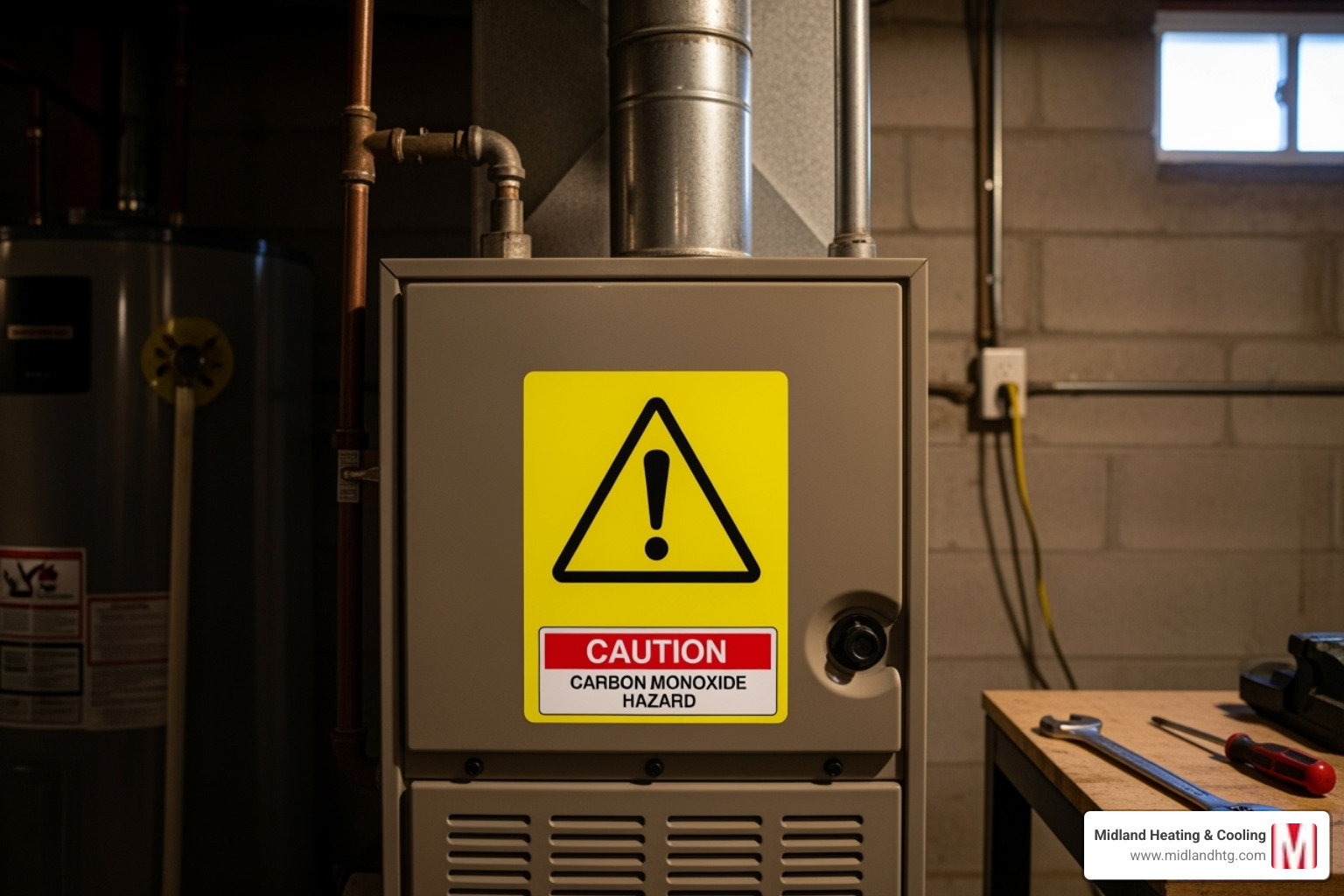Why Your Furnace Maintenance Schedule Matters More Than You Think
A furnace maintenance schedule is your roadmap to keeping your heating system running safely and efficiently throughout Minnesota’s harsh winters. Here’s what you need to know:
Essential Maintenance Timeline:
- Monthly: Check and replace air filters (every 1-3 months)
- Quarterly: Visual inspection, listen for unusual sounds, clear debris
- Annually: Professional tune-up in fall before heating season
- As needed: Address warning signs like strange noises or odors immediately
With the long list of things we need to maintain in our homes, it’s all too easy to forget furnace servicing. When winter rolls around and the temperature takes a dip for the first time, you might remember that you completely forgot to service your furnace.
The reality is simple: proactive maintenance prevents expensive emergency repairs and keeps your family safe from dangers like carbon monoxide leaks.
Regular furnace maintenance can add 5 to 10 years to your system’s lifespan while reducing the likelihood of needing major repairs. Professional tune-ups cost far less than emergency service calls during a Minnesota blizzard.
Your maintenance plan combines simple DIY tasks you can handle yourself with annual professional inspections that check critical safety components like the heat exchanger and gas connections.
The Core Benefits of a Consistent Furnace Maintenance Plan
We often hear the phrase “an ounce of prevention is worth a pound of cure,” and nowhere is this truer than with your home’s furnace. A consistent furnace maintenance schedule isn’t just about avoiding a chilly surprise in the dead of winter; it’s about safeguarding your comfort, your wallet, and your peace of mind. Let’s dig into the profound benefits we’ve seen homeowners enjoy when they commit to regular furnace care.
First and foremost, regular maintenance significantly boosts your furnace’s energy efficiency. Think of your furnace like a well-oiled machine (pun intended!). When all its components are clean, lubricated, and properly adjusted, it doesn’t have to work as hard to produce the same amount of heat. This directly translates to lower utility bills. A well-maintained system operates more efficiently, reducing energy consumption and increasing energy savings. Dirty components, like a clogged air filter or a dusty blower, force the system to exert more effort, consuming more fuel and driving up your heating costs. We’ve seen how a clean, efficient furnace can make a noticeable difference in monthly energy expenses for our customers across the Twin Cities, from Minneapolis to St. Louis Park.
Beyond daily savings, a robust maintenance plan also contributes to an extended equipment lifespan. Your furnace is a significant investment, and like any valuable asset, it needs protection. Regular check-ups can prevent premature wear and tear on vital components. It’s like getting regular oil changes for your car – it helps the engine last longer. Furnaces that receive consistent annual maintenance can often last 15 to 20 years, while those that are neglected might barely make it to 10. By extending the life of your system, you delay the costly expense of a full furnace replacement, saving you thousands in the long run.
Perhaps one of the most immediate and appreciated benefits is the reduction in fewer unexpected breakdowns. There’s nothing quite like a furnace deciding to quit on the coldest night of the year! Regular maintenance allows our certified technicians to identify minor issues before they escalate into major, expensive repairs. This proactive approach significantly reduces the likelihood of needing emergency service. In fact, regular maintenance can reduce the likelihood of needing major repairs, leading to estimated annual savings compared to emergency repairs or replacements. It helps us catch small problems, like a loose wire or a slightly off-kilter component, before they turn into a complete system failure. For more insights on common issues, you might find our guide on Common Heater Repair Problems and Solutions helpful.
Finally, and most critically, consistent furnace maintenance ensures improved home safety. Furnaces, especially gas-powered ones, involve combustion and produce exhaust gases. Neglecting maintenance can lead to serious safety implications. For instance, a cracked heat exchanger can allow dangerous carbon monoxide (CO) to leak into your home, an odorless and colorless gas that can be deadly. Improperly operating gas connections are a fire hazard and can contribute to health problems. Our professional tune-ups include thorough checks for gas leaks and carbon monoxide, giving you peace of mind that your home and family are safe. A flood-damaged furnace is extremely dangerous and attempts to use it can result in fire or explosion, highlighting the importance of professional assessment after any such event.
Your DIY Furnace Checklist: Simple Tasks for Every Homeowner
While professional maintenance is crucial, there are many simple, effective tasks you can perform yourself to keep your furnace humming happily between our visits. These DIY steps are your first line of defense against common issues and can significantly contribute to the overall health and efficiency of your heating system.
Crafting Your DIY Furnace Maintenance Schedule
We believe in empowering homeowners with the knowledge to maintain their systems. Here’s a breakdown of tasks you can tackle regularly:
- Monthly Tasks: The most frequent task on your furnace maintenance schedule will be checking your air filter (more on this below!). Beyond that, a quick visual inspection of your furnace area is always a good idea. Ensure the area around your furnace is clear of debris and combustibles. We recommend maintaining at least a few feet of clear space around the unit for safety and proper airflow.
- Quarterly Tasks: Every few months, take a moment to listen to your furnace while it’s running. Does it sound normal? Are there any new, unusual noises? Are the vents and air return ducts clear and unobstructed? You can also gently vacuum around the furnace’s exterior and any visible ducts to remove dust buildup. Cleanliness is next to efficiency! For more detailed DIY tips, check out our Effective Furnace Maintenance Tips.
The Critical Role of the Furnace Filter
If there’s one DIY task we emphasize above all others, it’s managing your furnace filter. This unsung hero plays a critical role in both your furnace’s health and your home’s indoor air quality.
Filter Replacement Frequency: Generally, you should replace or clean air filters every 1-3 months. Our experts often recommend replacing your furnace filter every three months as a good baseline. However, this frequency can vary significantly based on several factors:
- Pets: If you have furry friends, their dander and hair can quickly clog filters. For homes with one pet, changing filters every 60 days is a good idea. With multiple pets, or if your pets shed a lot, you may need to change it every 20-45 days.
- Allergies or Asthma: If someone in your household suffers from allergies or respiratory issues, more frequent filter changes (e.g., monthly) can significantly improve indoor air quality by trapping more airborne particles.
- Dusty Environments: Homes in construction zones or particularly dusty areas will also require more frequent changes.
Why it’s so important: The furnace filter collects common contaminants like dust, pollen, pet dander, and other airborne particles. A dirty air filter prevents efficient airflow through the HVAC system. This reduces the heating system’s performance, forcing your furnace to work harder and consume more energy to push air through the clogged filter. This increased strain can lead to higher energy bills and, more dangerously, may cause the system to overheat. A severely clogged filter can even result in an overheated and possibly cracked heat exchanger, leading to a dangerous carbon monoxide leak.
All furnace filters have a MERV rating, which indicates how many microns a furnace can collect. MERV ratings typically range from one to sixteen, with a higher rating indicating that fewer particles can pass through the filter. Understanding MERV ratings explained can help you choose the right filter for your home’s needs.
Changing your furnace filter is a straightforward process. First, always turn off the furnace before changing the filter. Locate the filter slot (usually near the blower motor), note the airflow direction arrow on the old filter, remove it, and insert the new filter, ensuring the arrow points in the direction of airflow towards the furnace. For a step-by-step guide, you can refer to How to change a furnace filter.
The Professional Tune-Up: What to Expect Annually
While DIY maintenance is a fantastic start, there are certain critical checks and services that only a trained, certified HVAC professional can perform safely and effectively. This annual inspection is the cornerstone of your comprehensive furnace maintenance schedule, ensuring safety, efficiency, and longevity for your heating system.
The Professional’s Role in Your Furnace Maintenance Schedule
We can’t stress enough the importance of scheduling an annual professional furnace tune-up. This isn’t just about cleaning; it’s a comprehensive health check for your entire heating system. When is the best time, you ask? The ideal time for a furnace tune-up is before winter arrives, typically in the fall. This ensures your system is ready to handle the demanding Minnesota winter and runs efficiently when you need it most. Scheduling in the fall also helps you avoid the pre-winter rush, allowing for more flexible appointment times.
Our certified technicians, like all skilled HVAC professionals, undergo extensive training to understand the intricate workings of your furnace. They know what to look for, what sounds are normal, and how to spot subtle signs of trouble before they become major headaches. If you’re curious about the expertise involved, our article on What an HVAC Technician Does provides a deeper dive.
During a professional furnace tune-up, our technicians perform a wide array of specific checks and services, including:
- Inspect Heat Exchanger for Cracks: This is one of the most critical safety checks. The heat exchanger separates the combustion gases from the air circulating in your home. Cracks can allow dangerous carbon monoxide to leak into your living space. This is a visual inspection that requires specialized knowledge and tools.
- Clean and Adjust Burner Assembly: Proper burner operation is vital for efficient combustion and safe heating. Our technicians will inspect the burner flames (which should be steady and blue), clean the burners to remove any soot or debris, and ensure proper alignment. A yellow or orange flame could indicate a problem with combustion or a gas leak.
- Test for Gas Leaks and Check Pressure: For gas furnaces, we carefully check all gas connections for leaks using specialized equipment and verify the gas pressure is within manufacturer specifications. This is a crucial safety measure that only a professional should perform.
- Clean Blower Motor and Wheel: The blower assembly is responsible for circulating heated air throughout your home. A dirty blower wheel can significantly reduce airflow and efficiency, forcing the motor to work harder and potentially leading to premature failure. We clean these components to ensure optimal air delivery.
- Inspect and Tighten Electrical Connections: Loose electrical connections can cause intermittent operation, reduce the lifespan of components, and even pose a fire hazard. Our technicians will inspect and tighten all electrical connections within the furnace.
- Test Safety Controls and Sensors: Furnaces are equipped with numerous safety controls, such as the flame sensor, limit switches, and rollout switches, which shut down the system if a problem is detected. We test these components to ensure they are functioning correctly and will protect your home in an emergency.
- Check and Clear Condensate Drain Lines: High-efficiency furnaces produce condensation during operation. We inspect and clear the condensate drain lines and traps to prevent clogs, which can lead to water damage, mold growth, or cause the furnace to shut down due to a blocked drain.
- Calibrate Thermostat: An accurate thermostat is essential for efficient and comfortable heating. We check your thermostat’s calibration and make adjustments if necessary, ensuring it accurately reads and controls your home’s temperature. This also includes checking the operational sequence of the furnace.
- Inspect Flue Pipe/Venting System: The flue pipe safely exhausts combustion byproducts out of your home. We check for obstructions, proper slope, and any signs of damage or corrosion that could lead to dangerous gas buildup.
This comprehensive list ensures that every essential component of your furnace is inspected, cleaned, and optimized for safe, efficient, and reliable operation throughout the heating season.
Warning Signs: When Your Furnace Needs Immediate Attention
Even with the most diligent furnace maintenance schedule, your system might occasionally throw you a curveball. Recognizing the signs that your furnace needs immediate attention is crucial. Ignoring these red flags can lead to costly repairs, a complete system breakdown, or, most importantly, unsafe conditions for your household. Knowing when to call a professional can save you a lot of trouble and expense. For a broader perspective on issues, our guide on Signs HVAC System Needs Professional Repair is a great resource.
Recognizing Urgent Furnace Problems
Here are the key indicators that your furnace is crying out for help:
- Unusual Noises: Furnaces typically operate with a consistent hum. If you start hearing new, strange sounds like banging, rattling, squealing, grinding, or popping, it’s a clear sign something is amiss. A banging noise could indicate issues with the blower motor or heat exchanger, while squealing might point to a failing belt or motor bearings.
- Strange Smells: While a slight burning dust smell is common when you first turn on your furnace for the season (as dust burns off the heat exchanger), persistent or strong odors are cause for concern. A musty odor indicates moisture and mold buildup inside the furnace, which can also cause allergies. The smell of rotten eggs, however, is a critical emergency. This indicates a natural gas leak, and you should immediately evacuate your home, contact your gas provider, and then call us. Never try to locate the source yourself or use electrical switches if you suspect a gas leak.
- Frequent Cycling or Short Cycling: If your furnace is turning on and off repeatedly within short intervals, it’s a problem known as frequent cycling or short cycling. This signifies something is wrong with your system. It could be due to a malfunctioning thermostat, a dirty filter restricting airflow, an oversized system, or issues with the blower motor or ignition system. This issue forces your furnace to work harder and can lead to premature wear. For more on this, read What frequent cycling means.
- Uneven Heating or Cold Spots: Are some rooms toasty while others remain chilly, no matter how high you crank the thermostat? Uneven heating or the presence of cold spots can indicate issues with your furnace’s ability to distribute heat effectively. This could be due to clogged filters, ductwork problems, or a malfunctioning blower.
- Yellow or Flickering Pilot Light: For older furnaces with a pilot light, its flame should always be a strong, steady blue. If you notice it’s yellow, orange, or flickering, it can be a sign of incomplete combustion, which could be producing carbon monoxide. This requires immediate professional attention.
- Sudden Spike in Energy Bills: If your heating costs suddenly jump without a corresponding increase in usage or a significant drop in outside temperatures, your furnace is likely losing efficiency. This often points to an underlying problem that needs to be addressed, such as dirty components, a failing part, or a lack of proper calibration.
If you observe any of these warning signs, especially the smells of gas or a yellow pilot light, prioritize safety and contact us immediately. Our technicians are available to diagnose and resolve these issues promptly, ensuring your home remains safe and warm.
Frequently Asked Questions About Your Furnace Maintenance Schedule
We understand that homeowners have many questions about keeping their heating systems in top shape. Here, we address some of the most common inquiries we receive regarding your furnace maintenance schedule.
How often should I service my furnace?
The general rule we recommend is to schedule a professional furnace tune-up at least once a year. Ideally, this should happen in the fall, before the heating season begins in earnest here in the Twin Cities. This annual check-up ensures your system is clean, efficient, and ready to handle the demands of winter.
However, certain factors may warrant more frequent attention:
- Older Furnaces: If your furnace is over 15 years old, it’s considered an older system and may be more susceptible to wear and tear. We might recommend more frequent check-ups, perhaps twice a year, to keep it running efficiently.
- Colder Climates: Living in a colder climate like Minnesota means your furnace works harder and longer. Increased usage can justify twice-yearly servicing to ensure optimal performance and longevity.
- Pets or Smokers: Homes with pets or smokers tend to accumulate more dust, dander, and airborne contaminants. This can lead to faster filter clogging and component buildup, making twice-yearly maintenance beneficial for air quality and system health.
- Manufacturer Guidelines: Always refer to your furnace’s manufacturer guidelines. Following their recommended furnace maintenance schedule is essential for optimal operation and can also be a condition for keeping your warranty valid.
Can I skip a year of professional furnace maintenance?
While it might seem like a way to save money in the short term, skipping annual professional furnace maintenance is strongly not recommended. It’s a common misconception that if your furnace is working, it doesn’t need a check-up. However, many problems develop silently.
Here’s why skipping is a bad idea:
- Voided Warranty: Many furnace manufacturers require proof of annual professional maintenance to keep your warranty valid. Skipping a year could mean you’re on the hook for expensive repairs that would otherwise be covered.
- Lower Efficiency and Higher Bills: Without regular cleaning and adjustments, your furnace will gradually lose efficiency. Components get dirty, parts become misaligned, and the system has to work harder. This directly translates to higher energy consumption and increased utility bills.
- Increased Risk of Breakdowns: Annual maintenance allows our technicians to catch small issues before they become major problems. A minor wear-and-tear issue that could be a simple fix during a tune-up might lead to a complete system breakdown if left unaddressed, leaving you in the cold when you least expect it.
- Safety Concerns: Critical safety checks, like inspecting the heat exchanger for cracks or testing for gas leaks, are only performed during professional tune-ups. Skipping these checks puts your household at risk of dangerous carbon monoxide leaks or fire hazards.
- Reduced Lifespan: Neglecting regular maintenance can shave years off your furnace’s expected lifespan, forcing you to invest in a costly replacement much sooner than necessary.
What is the single most important DIY maintenance task?
Without a doubt, the single most important DIY maintenance task you can perform for your furnace is changing your furnace filter regularly.
Here’s why it’s so crucial:
- Ensures Proper Airflow: A clean filter is vital for unrestricted airflow. When a filter gets clogged with dust, dirt, and debris, it acts like a dam, forcing your furnace to work harder to pull air through. This strain can lead to overheating and damage to critical components.
- Protects Your System: Restricted airflow from a dirty filter can cause the furnace’s heat exchanger to overheat and potentially crack. As we’ve discussed, a cracked heat exchanger is a serious safety hazard that can lead to carbon monoxide leaks. A clean filter protects your system from this kind of damage.
- Improves Efficiency: A furnace with a clean filter operates more efficiently, consuming less energy to heat your home. This directly contributes to lower energy bills.
- Maintains Indoor Air Quality: Your filter captures dust, pollen, pet dander, and other airborne particulates, preventing them from circulating throughout your home. A clean filter ensures the air you breathe is cleaner and healthier, especially important for those with allergies or respiratory sensitivities.
We recommend checking your filter monthly and replacing it every 1 to 3 months, depending on factors like pets, allergies, and general household dust. It’s a simple, inexpensive task that yields significant benefits for your furnace and your home’s comfort and safety.
Stay Warm and Safe with a Reliable Maintenance Plan
As we’ve explored, crafting and adhering to a comprehensive furnace maintenance schedule is not just about keeping warm; it’s about investing in the longevity, efficiency, and safety of your home’s heating system. We’ve seen the difference proactive care makes for homeowners across the Twin Cities, from Edina to Wayzata.
The key takeaway is a balanced approach: combine the simple, regular DIY tasks you can handle yourself, like changing filters and keeping the area clear, with an annual professional tune-up performed by certified experts. This dual strategy covers all bases, addressing both immediate needs and complex internal system health.
The benefits are clear and compelling:
- Improved Safety: Regular checks for gas leaks, carbon monoxide, and faulty components protect your family from hidden dangers.
- Significant Cost Savings: Improved energy efficiency translates to lower monthly utility bills, and preventing major breakdowns saves you from expensive emergency repairs and premature system replacement.
- Peace of Mind: Knowing your furnace is running safely and efficiently provides invaluable comfort, especially during the chilliest Minnesota winters.
Since 1950, we at Midland Heating & Cooling have been dedicated to providing comprehensive heating and cooling services to our neighbors in the Twin Cities and surrounding areas like Minnetonka, Hopkins, and Bloomington. Our commitment to 100% customer satisfaction, certified technicians, and flexible, on-time service has built our reputation as a trusted partner in home comfort.
Don’t wait for your furnace to whisper (or groan!) for attention. Take control of your home’s comfort and safety today. Schedule your professional furnace maintenance today and let us help you craft a timeline that keeps your home warm, safe, and efficient, year after year.


